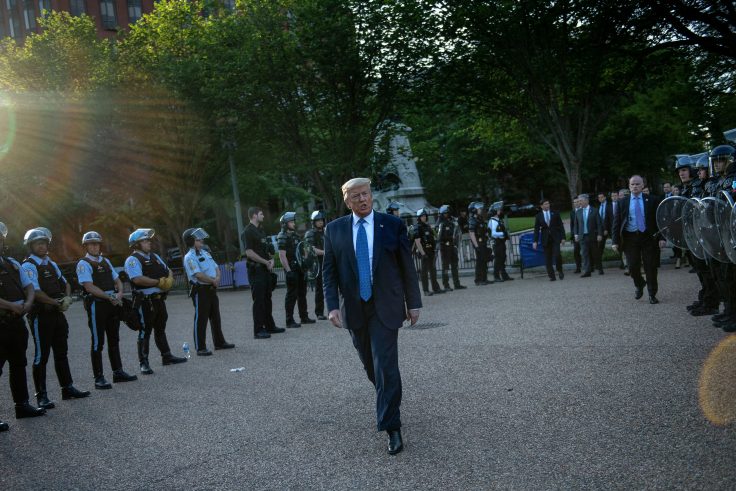Black Lives Matter's Washington, D.C., affiliate is suing President Donald Trump over the measures his administration took to disperse protesters in Lafayette Square ahead of his June 1 visit to St. John's Episcopal Church.
In a new federal lawsuit, the affiliate's ACLU lawyers say the government had "no legitimate basis" to clear the square, arguing that the use of flash bombs and rubber bullets against protesters "is a continuation of an unlawful history of oppression of civil rights activists." Attorney General William Barr, Secretary of Defense Mark Esper, various agency heads, and unidentified law enforcement officers are also named as defendants.
The lawsuit accuses Trump, Barr, and others of constitutional violations and conspiracy to violate civil rights. The plaintiffs are also bringing Bivens claims against law enforcement at the scene, a cause of action available against police for unconstitutional conduct under a 1971 Supreme Court case.
The government's move to clear the square sits at the apex of an ongoing national debate over the use of force against demonstrations prompted by the killing of George Floyd by Minneapolis police officers. The ACLU said the Lafayette Square suit is the first of many actions it plans to bring against authorities around the country for what they call police brutality.
BLM and the ACLU claim the decision to clear the square and the dispersal measures used violated free speech rights and the Fourth Amendment right to protection from unwarranted seizure. They claim the defendants' actions were "the manifestation of the very despotism against which the First Amendment was intended to protect."
The status of Lafayette Square will be a major issue in the suit. The complaint says the square is a historic venue frequently used by activists given its proximity to the White House. But government lawyers may counter that it had a special interest in protecting the White House campus during a period of unrest, justifying the actions taken to scatter the crowd.
In a Thursday press conference, Barr situated the June 1 protest within the broader trend of unrest and rioting in the preceding days, much of which centered around the White House. He said he made the decision to extend the perimeter around the White House by one block earlier in the day, after rioters burned a historic building on Lafayette Square over the weekend, attacked St. John's, and wounded police during clashes in the area.
The U.S. Park Police said in a statement that officers found caches of "glass bottles, baseball bats, and metal poles" hidden in the area. They also cited contested reports that protesters hurled projectiles and "caustic liquids" in the moments before the square was cleared. The plaintiffs vigorously dispute claims that the June 1 demonstration was unruly and catalogue injuries demonstrators incurred at some length, including cuts and bruises.
The lawsuit cites Trump's tweets, press conferences, and a call with the nation's governors in which he urged authorities to "dominate" criminals, saying they manifest threats against First and Fourth Amendment rights. Trump is not named in connection with more specific claims relating to clearing the square itself.
The plaintiffs requested compensatory and punitive damages, as well as attorneys fees. The Department of Justice declined to comment for this story.
The matter was assigned to U.S. District Judge Dabney Friedrich. The case is Black Lives Matter D.C. v. Trump in the U.S. District Court for the District of Columbia.
Complaint Black Lives Matte... by Washington Free Beacon on Scribd
